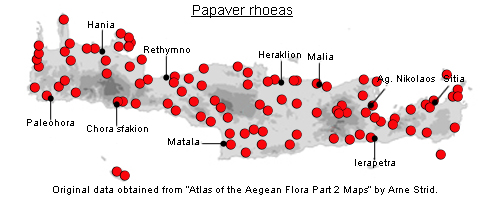SPECIES DESCRIPTION
PAPAVER RHOEAS
Family:- PAPAVERACEAE/Sect. RHOEADIUM
Common Names:- Common Poppy, Corn Poppy, Corn Rose, Corn-poppy,
Field Poppy, Red Poppy.
Synonyms:- P. guerlekense, P. seudo-haussknechtii, P. robertianella, P.
rumelicum, P. somniferum ssp. setigerum, P. stipitatum, P. subumbilicatum,
P. tenuissimum, P. strigosum,
Meaning:- Papaver (L) Poppy.
Rhoeas (Gr) The old generic name of the field poppy.
General description:- Variable medium to tall, rather bristly annual.
Leaves:- Alternate, deeply divided into lance-shaped lobes, with hairy, sometimes
toothed segments.
Flowers:- Red, solitary, from 40-100 mm diam., carried by long stalks with white or
red spread out hairs. Corolla with 4 free petals, sometimes with black marks at the
base. Stamens numerous, free between them, with narrow and reddish filaments,
bluish or purplish anthers. Style with 7-12 stigmas spreading from the centre on a
disc.
Fruit:- Capsule 0·5-1·6 x 0·4-1·4 cm, 1-2 times as long as wide, usually broadly
obovoid, cylindrical or almost globose, sometimes shortly stipitate, usually more or
less abruptly contracted at base. Disc usually wider than capsule, sometimes
slightly umbonate, with 6-16 rays.
Key features:-
1) Pedicel setae usually patent, sometimes loosely appressed.
2) Capsules usually less than twice as long as wide.
3) Stigmatic disc usually wider than the capsule.
Habitat:- Weed of cereal fields, roadsides and wasteground. 0-800(-1200) m. often
gregarious, occasionally to 1800 m. along mountain tracks.
Distribution:- Widespread and common throughout the Mediterranean region.
Widespread and common on Crete.
Flowering time:- Mid-Apr to mid- June, sometimes later.
Photos by:- Steve Lenton
FAMILY AND GENUS DESCRIPTIONS
PAPAVERACEAE
General description:- Herbs with or without latex.
Leaves:- Usually spirally arranged, variously dissected.
Flowers:- Hermaphrodite, actinomorphic or zygomorphic, hypogynous. Sepals 2
(3), falling early (caducous). Petals 4-6. Stamens 2, 4 or numerous, whorled. Ovary
superior, 1-celled, 2-celled or imperfectly many-celled; carpels 2 to many.
PAPAVER
General description:- Annual, biennial or perennial herbs with latex.
Flowers:- Sepals 2 or 3, usually caducous. Petals 4 or 6, usually entire, often
bright red, crumpled in bud, usually caducous. Stigmas 4-16, sessile over the
placentae. Capsule club-shaped (clavate) to globose, opening by valves or pores
below the stigmatic disc, or disc deciduous.
Fruit:- Seeds kidney-shaped (reniform), without aril.
Sect. RHOEADIUM
General description:- Annuals with few to many usually setose hairs.
Leaves:- Pinnatisect to pinnatipartite; upper cauline leaves not amplexicaul; lower
leaves petiolate.
Flowers:- Filaments filiform, dark violet.
Fruit:- Capsule glabrous.
MEDICINAL AND HERBAL USES
Researched and written by Enda McMullen
The appearance of the poppy heralds the arrival of warmer weather and carries with
it hints of summer. The poppy plays a very important role in the history of medicine,
with evidence of its medicinal uses going back as far as 4000BC. And then there
are of course the stories and myths....
Poppy seeds are used in baking, as most of us would know. But they have a much
more powerful property as a pain killer and a relaxant. My grandmother had her
"magic sweets" which helped us sleep when we were too wound up to do so. These
consisted of crushed poppy seeds rolled into small little balls using solid honey as
a binding agent. Very much in the same way as Traditional Chinese Medicine pills
are made. The same magic sweets were effectively used as a painkiller specifically
for headaches, toothaches and earaches.
In antiquity, the poppy was related to a few different Gods, none in the least
Hypnos, Hades and Aphrodite. It was also the main ingredient in θηριακή, a
concoction of 64 ingredients invented by Aνδρόμαχος, the 1st century Cretan
physician (also credited with writing the first scientific work on pharmacy), and
administered as a cure for poisoning, mostly by venomous snake bites. This
remedy is often referred to by that other great Greek physician Galen (Κλαύδιος
Γαληνός), and was based on the "work" by Mithridates VI of Pontus, the dr.
Mengele of antiquity who used prisoners for his experiments with poisons. Many
dead prisoners later, he claimed to have found an omni-cure for all forms of
poisoning.... It is worth noting that Theriac is in essence a homeopathic remedy,
using like to cure like
